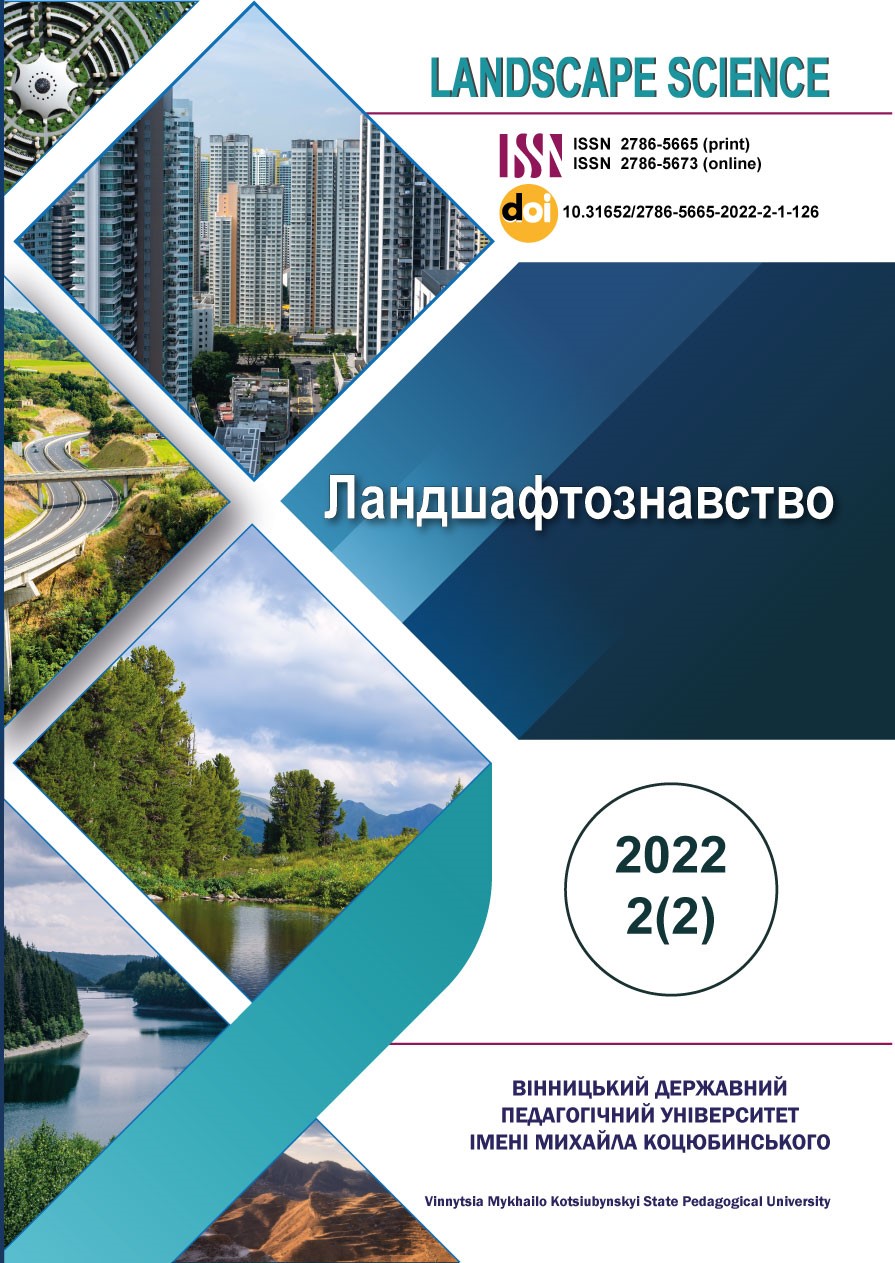Abstract
The delineation of regions that are specific not so much for the features of their structure as for the factors of their formation was tested in various environmental sciences: pedology (M. Glazovskaya), geochemistry (A. Perelman), geomorphology (V. Paliyenko), paleogeography (M. Veklych). Mapping and analysis of regions of this type allowed these sciences to better understand the spatio-temporal differentiation of evolutionary processes of the objects of their study. However, in landscape science there is still no experience in delineating regions that are specific primarily to the evolutionary processes and trends of their formation and only secondarily to the attributes of modern landscapes. The article proposes the concept of landscape-evolutionary region, the scheme of landscape-evolutionary zoning for the area of Ukraine, and the short description of these regions. Coincidences and differences between the schemes and principles landscape-evolutionary and physical-geographical zoning are also discussed. The landscape-evolutionary region is defined as an area where the characteristic composition of processes and evolutionary trends of modern landscape formation prevailed. Criteria for mapping landscape-evolutionary regions are directly related to the evolutionary factors of their formation, while physical-geographical regions are specific for the tangible results of these factors, for evolutionarily determined features of modern landscapes. The proposed scheme of landscape-evolutionary zoning of Ukraine includes regions of three taxonomic levels: mega-, macro- and mesoregions. The territory of Ukraine lies in two megaregions - the Eastern European Plain and the Alpine Mountain. According to the leading factors of landscape evolution, the East European Plain is divided into two landscape-evolutionary macroregions - Polisskyi post-glacial and Ukrainian loess. The landscape-evolutionary mesoregions are numerous in Ukraine. Their classification is based on the dominant processes of soil development and plant successions in the Holocene
References
Veklych M.F., Sikrenko N.A. (1976). Pliocene and Pleistocene of the Lower Left-Bank Dnipro and Plain Crimea. Kyiv, 186 p. [In Russian]. [Веклич М.Ф., Сиренко Н.А. Плиоцен и плейстоцен Левобережья Нижнего Днепра и Равнинного Крыма. К.: Наук. думка, 1976. 186 с.].
Strategraphic scheme of Quartenary deposits of Ukraine. Veklych M.F., Sikrenko N.A., Matvijishina J.M. e.a. (1993). Stratigraphic scheme of the Quaternary deposits of Ukraine. Stratigraphic schemes of the Phanerozoic and Precambrian of Ukraine. Kyiv, 40 p. [In Russian]. [Веклич М.Ф., Сиренко Н.А., Матвиишина Ж.Н. и др. Стратиграфическая схема четвертичных отложений Украины. Стратиграфические схемы фанерозоия и докембрия Украины. К.: Госкомитет геологии Украины, 1993. 40 с.].
Gerasimenko N.P. (2004). Development of zonal ecosystems in Ukraine during the Quaternary. Thesis for the scientific degree of Doctor of Geogr. Sciences. The Institute of Geography of NAS of Ukraine. Kyiv, 38 p. [In Ukrainian]. [Герасименко Н.П. Розвиток зональних ландшафтів четвертинного періоду на території України / Автореф. дис.. д-ра геогр.н. Київ: Ін-т географії НАН України, 2004. 38 с.
Glazovskaya M.A. (2002) Geochemical foundations of typology and methodoloogy of the study of natural landscapes. 2nd ed. Smolensk. 288 p. [In Russian]. [Глазовская М.А. Геохимические основы типологии и методики исследований природных ландшафтов. 2-е изд. Смоленск: Ойкумена, 2002. 288 с.].
Grodzynskyi M.D. (2019). Middle Holocene post-agricultural steppization – the first in the area of Ukraine anthropogenic landscapes transformation of regional scale. Ukrainian Geogr. Journal 2019, 2(106). P. 3-12. [In Ukrainian]. [Гродзинський М.Д. Середньоголоценове постагрікультурне остепнення – перше на території України антропогенне перетворення ландшафтів регіонального масштабу // Український географічний журнал, 2019. Вип 2. С. 3-12.].
Grodzynskyi M.D. The Evolution of Landscapes of Ukraine in Holocene from Landscape ecological perspective. Bydgoszcz. 204 p. [In Ukrainian]. [Гродзинський М.Д. Еволюція ландшафтів України в голоцені у ландшафтно-екологічному вимірі. Bydgoszcz: Wydawnictwo UKW, 2020 . 204 s.].
Landscapes: map – scale 1:2500 000. O.M. Marynych, V.M. Pashchenko, O.M. Petrenko, P.G. Shyshchenko (eds). National Atlas of Ukraine (2007). Kyiv. P. 222-224. [In Ukrainian]. [Ландшафти: карта - 1:2500 000 / О.М.Маринич, В.М.Пащенко, О.М.Петренко, П.Г.Шищенко // Національний Атлас України / Гол. ред. Л.Г.Руденко. – К.: ДНВП „Картографія”, 2007. С. 222 – 224.].
Marynych O.M., Shyshchenko P.G. (2003). Physcial Geography of Ukraine. Kyiv. 479 p. [In Ukrainian]. [Маринич О.М., Шищенко П.Г. Фізична географія України. – К.: Знання, 2003. – 479 с.].
Martsinkevych G.I., Klicunova N.K., Schastnaya I.I., Yakushko O.F. (2001) Hysical-geographical zoning of Belarus in the European decimal system of zoning. Vestnyk of Belorussian State Univ. Series Chemistry. Biology. Geography. No 1. P. 85-90. [In Russian]. [Марцинкевич Г.И., Клицунова Н.К., Счастная И.И., Якушко О.Ф. Физико-географическое районирование Беларуси в европейской десятичной системе районирования. // Вестник БГУ. Сер. 2. Химия. Биология. География, 2001, № 1. С. 85-90.].
Negru A.G. (1986) Meotic flora of the northwestern Black Sea region. Chișinău. 195 p. [In Russian]. [Негру А.Г. Меотическая флора северо-западного Причерноморья. Кишинев: Штиинца, 1986. 195 с.].
Novikova G.V. (2010) On the issue of the importance of aerial salts in the alkalization of the soils of Prychernomorya. Agrocymistry and Soil Science. Vol. 73. P 31-41. [In Ukrainian]. [Новікова Г.В. До питання про значимість аеральних солей в осолонцюванні ґрунтів Причорномор'я. // Агрохімія і ґрунтознавство. 2010. Вип. 73. С. 31-41.].
Palienko V.P. (1992). The newest geodynamics and its reflection in the landscape of Ukraine. Kiev. 116 p. [In Russian]. [Палиенко В.П. Новейшая геодинамика и ее отражение в рельефе Украины. К.: Наук. думка, 1992. 116 с.].
Palienko V.P., Barshchevskyi M.Ye., Bortnyk S.Yu. e.a. (2004). General geomorphological zoning of the territory of Ukraine. Ukrainian Geogr. Journal. 2(106). P. 3-11. [In Ukrainian]. [Палієнко В.П., Барщевський М.Є., Бортник С.Ю. та ін. Загальне геоморфологічне районування території України. // Укр. Геогр. журн. 2004. No 1. С. 3–11.].
Perelman A.I. (1972) Geochemistry of the elements in the zone of hypergenesis. Moscow. 288 p. [In Russian]. [Перельман А.И. Геохимия элементов в зоне гипергенеза. – Москва: Недра, 1972. 288 с.].
Sirenko E.A. (2017) Palynostratigraphy of continental upper Pliocene-lower Neopleistocene deposits of Southern part of the East European platform. Kyiv. 165 p. [In Russiioan]. [Сиренко Е.А. Палиностратиграфия континентальных верхнеплиоценовых-нижнеплейстоценовых отложений южной части Восточно-Европейской равнины. К.: Наук. думка, 2017. 165 с.].
Maciejowski W. Regionalizacja fizycznogeograficzna – przeszłość czy przyszłość geografii fizycznej? // Problemy ekologii krajobrazu, 2009, T. XXIII. – S.115–127.

This work is licensed under a Creative Commons Attribution 4.0 International License.
Copyright (c) 2023 Михайло Дмитрович Гродзинський

